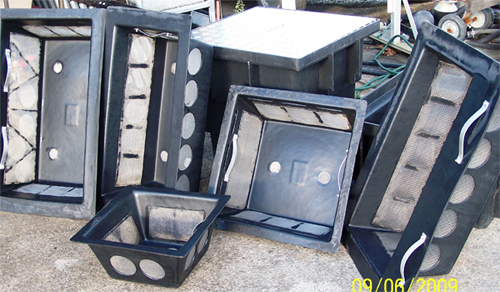
SQID®
Introduction

(Photo 1 Range of products)
Overview:
Design objective:- "To provide an economical, hydraulically efficient, easy to install and simple to maintain device, that aids in improving storm water quality by the removal of litter and sediment pollutants, which have historically been transported to a sensitive aquatic ecosystems".
The SQID ® (Stormwater Management Device) range of products is designed with durability and UV stability built-in. Constructed of polyethylene and stainless steel, these products are designed to last. Once manufactured and installed, these products contribute no more pollution to the environment, and are made of 100 percent recyclable materials.
Authorities have begun to act to ensure that storm water pollutants are captured at the source. With this in mind, the SQID ® range of litter and sediment traps (LST) were developed.
The SQID® litter and sediment traps would become an integral part of a storm water treatment plan that councils are being urged to implement. (See: Modern urban storm water quality management plans and guideline, March 2001, Queensland Government Environmental Protection Agency.) It is envisaged that this will help reduce the impact of urban development on the ecosystem. This will greatly improve the likelihood of sustainable development. Developers will also benefit by installing the SQID ® systems, as this may facilitate development plans if they are seen to be ecologically sound.
The systems are primarily designed to capture and maintain sediment and pollutants from areas such as industrial areas, car parks, courtyards, driveways and kerbside channelling. There are many various applications that the SQID ® systems may be useful.
Uses and Applications:
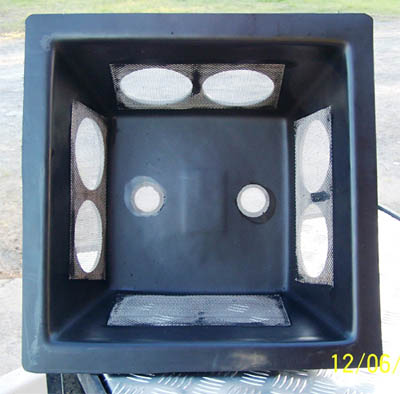 |
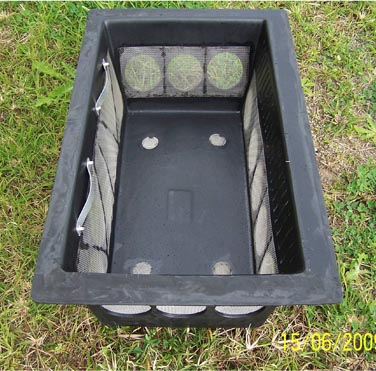 |
The 450 SQID® Range The SQID® is a pit insert for the primary treatment of storm water at the source. The new SQID® is for use in driveways, gardens and court yards. The range of SQID® are manufactured from UV |
The 49060 Model SQID® The SQID® is a pit insert for the primary treatment of storm water at the source. ThIs SQID® is for use in kerb inlet pits, carparks, industrial driveways, gardens and court yards. The range of SQID® are manufactured from UV |
 |
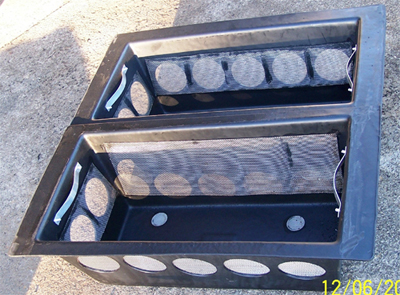 |
The 49060 RE Model SQID® The SQID® is a pit insert for the primary treatment of storm water at the source. ThIs SQID® is for use on roadways and industrial driveways. |
The 49090 2 Part Model SQID® This model is designed for field gully pits in large area carparks., industrial driveways,fields and parks. The treatment size range is 900 mm X 900 wide. Flow rate are approx 140 lps and in addition they can be fitted under grates if required. The by pass is in the centre overlaps or through the Sqid wall..Flow has to go through the treatment and these will be required to be occluded before the by pass is required |
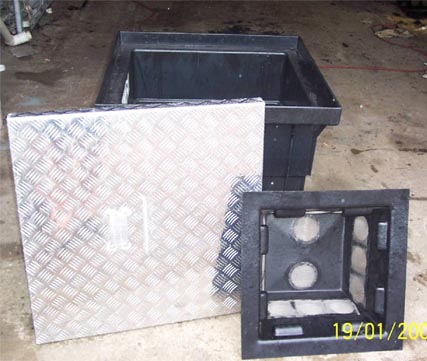 |
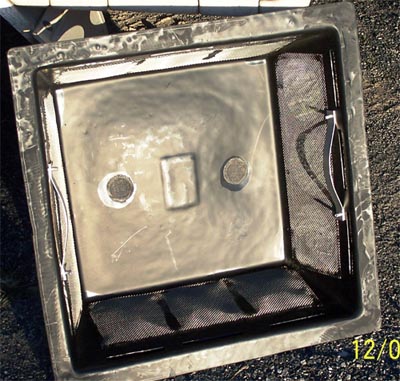 |
Infiltration system The Sqid InFil-trator 450 provides a superior The Sqid InFil-trator 450 incorporates a SQID® inspired insert filter basket, durable polyethylene pit & |
The 46060 ModelSQID® The SQID® is a pit insert for the primary treatment of storm water at the source. ThIs SQID® is for use in carparks, industrial driveways, gardens and court yards. The range of SQID® are manufactured from UV |
Environmental benefits:
The benefits to the environment are immeasurable. Many of these have been discussed in lengthy papers and reports by environmental agencies over time. Some of these include the reduction of discarded and trimmed vegetation that depletes the oxygen levels in water as it decomposes, thus contributing to the blue green algae problem. Cigarette butts are stopped at the source. These cause immeasurable damage to the ecosystem as they have life expectancy far exceeding that of natural components. Plastic bags, broken bottles, discarded wrappers, and all forms of litter otherwise known as gross pollutants are stopped at the source. All these items have been found to be trapped by the SQID ® systems.
It has been found with field observation and experiments that as the litter and sediment is trapped, there is a tendency for Pollutants such as nutrients, trace metals, free oil and grease as well as smaller particles below 2 mm to be entrapped in the litter is well, thus reducing further pollutants to the ecosystem. See (Figure 1)
|
Pollutant Description |
Possible Pollutant Source |
|
Gross Pollutants (Litter and Debris) |
Pedestrians and vehicles Waste collection processes Large vegetative matter Lawn Clippings
|
|
Sediment |
Soil erosion – wind and water Pavement and vehicle wear Atmospheric deposition Organic matter Car washing Weathering of buildings & structures |
|
Oxygen Demanding Substances |
Organic matter decay Atmospheric deposition Animal faeces |
|
Nutrients |
Organic matter Atmospheric deposition Animal faeces |
(Figure 1 Pollutant Table).
(Source: Design Guidelines for Stormwater Quality Improvement Devices,
Brisbane City Council, 1999)
Cost benefits:
Apart from being a relatively cheap product, the other cost benefits include the reduction of blockage risks further down the line, and the reduction in the need for replacement pipes due to the scouring effect that larger particle size, e.g. broken roadway, being carried down at high velocity inside the pipes chipping away at the concrete and PVC.
Cleaning and maintenance:
As is the case with any intervention device, there is a degree of maintenance needed. The smaller devices are designed with handles, and can be easily removed and emptied, with the debris being put in landfill sites. The larger devices can be cleaned out by hand, or with a small adaptation on the end of the road sweeper swinging arm device, can be cleaned by road service crew.
There are also other products available to facilitate speedy maintenance and cleaning of these devices. Please see your representative for further details.
Manufacturers recommendation that after a significant storm event, the devices are emptied, however, these devices are built-in with an overflow mechanism that allows them to function as a bypass unit when the treatment flow of the device is 100 percent blocked. (See technical details for further information).
Installation:
These devices can be retrospectively fitted into most existing pits and gullies with minor adaptations. Your representative will be only too happy to talk to you about the procedures and may also arrange to have them fitted for you.